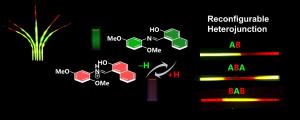New Flexible Crystals for Optical Tuning with Multiple Deformation Options
USA, June 5, 2024 /EINPresswire.com/ -- Researchers developed Schiff base crystals with unique bending, twisting, and acid-induced deformations, enabling adjustable color emission from green to deep red via protonic acid vapor. These crystals can be reconfigured through reversible protonation, offering new opportunities for flexible, lightweight optoelectronic devices and tuners. This breakthrough demonstrates the potential of organic crystals in creating adaptable optical structures for wearable electronics.
In recent years, significant strides to enhance the functionality and adaptability of devices have been taken in the field of optoelectronics aiming. Now, a team of scientists from State Key Laboratory of Supramolecular Structure and Materials, College of Chemistry, Jilin University, reported a breakthrough in the development of organic flexible optoelectronic devices using acicular organic crystals.
The crystals, which range from micro- to centimeter-scale in length, have been used as media for transducing optical signals, functioning as active or passive optical waveguides. By integrating the dynamic adaptability of crystals with optical waveguides, the researchers have opened new possibilities for creating crystal-based devices.
“We introduced a Schiff base crystal with remarkable properties, including integrated elastic-bending, plastic-twisting, and acid-bending deformations, alongside protonation-induced crystal acidichromism,” said Hongyu Zhang, corresponding author of the study. “This unique combination allows the emission color of a single crystal to be selectively and reversibly controlled, varying between green (554 nm) and deep red (659 nm) when exposed to protonic acid vapor. This color change creates various block heterojunction structures that can be easily identified by their distinct colors and emissions."
The researchers emphasized that the Schiff base they prepared combines multiple flexibilities and optical output tunability. The crystals exhibit excellent bending elasticity and twisting plasticity, which can be independently controlled.
“Notably, the heterojunction structures, formed through partial acid-fuming of slender crystals, display an erasing-rewriting feature, allowing for the reconfigurable regulation of emission outputs,” adds Zhang. “This reconfiguration capability enhances the practicality of the crystals in developing flexible optical tuners with a wide range of adjustable output signals.”
The compatibility of the crystals' mechanical properties and acidichromism further enhance their functionality. The study's results (https://doi.org/10.1016/j.wees.2024.05.003), published in the KeAi journal Wearable Electronics, demonstrate the potential of designing reconfigurable optical structures using organic crystals, paving the way for their application in lightweight and wearable electronic devices.
DOI
10.1016/j.wees.2024.05.003
Original Source URL
https://doi.org/10.1016/j.wees.2024.05.003
Funding information
This work was supported by the National Natural Science Foundation of China (52173164, 52373181) and the Natural Science Foundation of Jilin Province (20230101038JC).
Lucy Wang
BioDesign Research
email us here
Legal Disclaimer:
EIN Presswire provides this news content "as is" without warranty of any kind. We do not accept any responsibility or liability for the accuracy, content, images, videos, licenses, completeness, legality, or reliability of the information contained in this article. If you have any complaints or copyright issues related to this article, kindly contact the author above.

